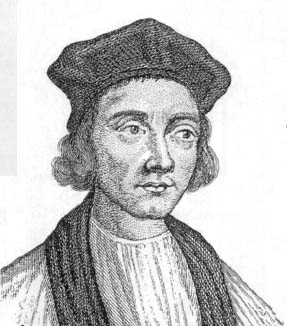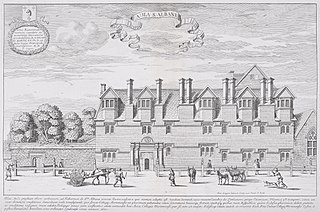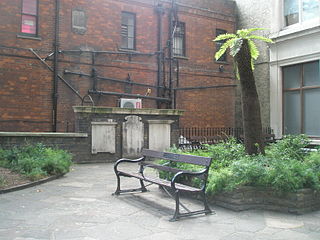Related Research Articles

Saint Albans is a cathedral city in Hertfordshire, England, east of Hemel Hempstead and west of Hatfield, 20 miles (32 km) north-west of London, 8 miles (13 km) south-west of Welwyn Garden City and 11 miles (18 km) south-east of Luton. St Albans was the first major town on the old Roman road of Watling Street for travellers heading north and became the city of Verulamium. It is within the London commuter belt and the Greater London Built-up Area.

Sir Nicholas Bacon was Lord Keeper of the Great Seal during the first half of the reign of Queen Elizabeth I of England. He was the father of the philosopher and statesman Sir Francis Bacon.

Cuthbert Tunstall was an English Scholastic, church leader, diplomat, administrator and royal adviser. He served as Prince-Bishop of Durham during the reigns of Henry VIII, Edward VI, Mary I and Elizabeth I.

William Paulet, 1st Marquess of Winchester, styled Lord St John between 1539 and 1550 and Earl of Wiltshire between 1550 and 1551, was an English Lord High Treasurer, Lord Keeper of the Great Seal, and statesman.

Thomas Beccon or Becon was an English cleric and Protestant reformer from Norfolk.

Sir Thomas Cheney KG of the Blackfriars, City of London and Shurland, Isle of Sheppey, Kent, was an English administrator and diplomat, Lord Warden of the Cinque Ports in south-east England from 1536 until his death.
John Willock was a Scottish reformer. He appears to have been a friar of the Franciscan House at Ayr. Having joined the party of reform before 1541, he fled for his life to England. There he became noted as a zealous and taking preacher. This led to his arrest for heresy under an Act of Henry VIII., "for abolishing diversity of opinion" in matters of religion. He was found guilty of preaching against purgatory, holy water, priestly confession, and prayer to the saints, and of holding that priests might lawfully be married, he was for some time confined in the Fleet prison. After the accession of Edward VI he was chaplain to Henry, Duke of Suffolk, who had married King Henry's niece, and is best known as the father of Lady Jane Grey. He preached for a time in London, in St Katherine's Church, when both he and John Knox, his fast friend, were granted general license to preach anywhere in England. Henry, Earl of Huntingdon, presented him to the rectory of Loughborough in Leicestershire, a living which he continued to hold during King Edward's reign, and again during that of Queen Elizabeth for the rest of his life. Thus in his later years he was in the unique position of being at the same time a parish minister in both England and Scotland. When Mary Tudor came to the English throne in 1553, Willock fled to Embden, in the Protestant Duchy of Friesland. There he practised as a physician with much success, and rose to some eminence. In 1555, and again in 1556, the Duchess Anne of Friesland sent him to Scotland as her Commissioner on matters of trade. In 1558 he returned home, and preached for some time in Dundee, with much acceptance among the friends of reform. In 1559, when John Knox had to leave Edinburgh in peril of his life, Willook took his place as the evangelist of the Reformation. It was then that he conducted in St Giles what is believed to have been the earliest public celebration of the Holy Communion in Scotland after the reformed ritual. In 1560, when Queen Mary of Guise lay dying, the Earls of Argyll and Moray, and other Lords of the Congregation advised her to "send for a godly, learned man of whom she might receive instruction"; and Willock was chosen to minister to her, which he faithfully did. That same year he was made Superintendent of Glasgow and the West. He was also one of the six Johns entrusted with the drawing up of the First Book of Discipline, the others being John Knox, John Winram, John Spottiswood, John Douglas, and John Row. Sometime in that year he went to England, and brought home his wife, Katherine Picknavell, an English lady. He was chosen Moderator of the General Assembly in 1563, 1564, 1565, and 1568. In 1565 Queen Mary endeavoured to put a stop to his activity by having him imprisoned in Dumbarton Castle; but the Reformers were now too strong for her, and she had to depart from her purpose.

Saint Alban is venerated as the first-recorded British Christian martyr, for which reason he is considered to be the British protomartyr. Along with fellow Saints Julius and Aaron, Alban is one of three named martyrs recorded at an early date from Roman Britain. He is traditionally believed to have been beheaded in Verulamium sometime during the 3rd or 4th century, and his cult has been celebrated there since ancient times.
John Scory was an English Dominican friar who later became a bishop in the Church of England.

St Alban Hall, sometimes known as St Alban's Hall or Stubbins, was one of the medieval halls of the University of Oxford, and one of the longest-surviving. It was established in the 13th century, acquired by neighbouring Merton College in the 16th century but operated separately until the institutions merged in the late 19th century. The site in Merton Street, Oxford, is now occupied by Merton's Edwardian St Alban's Quad.
Benedict Barnham was a London merchant, alderman and sheriff of London and MP.

Sir William Cordell of Melford Hall in the parish of Long Melford, Suffolk, was an English lawyer, landowner, administrator and politician who held high offices under both the Catholic Queen Mary I and the Protestant Queen Elizabeth I.

St Peter, Westcheap, also called "St Peter Cheap", "St Peter at the Cross in Cheap", or "Ecclesia S. Petri de Wodestreet", was a parish and parish church of medieval origins in the City of London. The church stood at the south-west corner of Wood Street where it opens onto Cheapside, directly facing the old Cheapside Cross. In its heyday it was a familiar landmark where the City waits used to stand on the roof and play as the great processions went past. It was destroyed in the Great Fire of London in 1666, together with most of its surroundings, and was never rebuilt.
John Clement was an English Roman Catholic physician and humanist. He was tutor to Thomas More's children, and became President of the College of Physicians.
John Coldwell (c.1535–1596) was an English physician and bishop.
Walter Haddon LL.D. (1515–1572) was an English civil lawyer, much involved in church and university affairs under Edward VI, Queen Mary, and Elizabeth I. He was a University of Cambridge humanist and reformer, and was highly reputed in his time as a Latinist. He sat as an MP during the reigns of Mary and Elizabeth. His controversial exchange with the Portuguese historian Jerónimo Osório attracted international attention partly on account of the scholarly reputations of the protagonists.
Dr. Calybute Downing (1606–1643) was an English clergyman, a member of the Westminster Assembly. Also a civil lawyer, he is now remembered for political views, which moved from an absolutist position in the 1630s to a justification of resistance to authority by 1640, within a contractarian setting.
Richard Masters was a leading 16th-century English physician and personal doctor of Queen Elizabeth.
John Gwynneth, was a clergyman of Welsh nationality originating from Gwynedd, and was a composer of religious and liturgical vocal music for which he was awarded a doctorate in the University of Oxford. He held benefices in England in Northamptonshire, Bedfordshire and London, and in North Wales at Clynnog Fawr. Although he was a polemicist for the Catholic faith, he maintained his ministry through the reigns of Henry VIII, Edward VI and Queen Mary, and was brother-in-law and executor of Stephen Vaughan. He is principally remembered, from the age of Thomas Tallis, as one of the other exponents of early Tudor period polyphony.

Merryfield is a historic estate in the parish of Ilton, near Ilminster in Somerset, England. It was the principal seat of the Wadham family, and was called by Prince their "noble moated seat of Meryfeild" (sic). The mansion house was demolished in 1618 by Sir John Wyndham (1558–1645), of Orchard Wyndham, a nephew and co-heir of Nicholas II Wadham (1531–1609), co-founder of Wadham College, Oxford, the last in the senior male line of the Wadham family. It bears no relation to the present large 19th-century grade II listed mansion known as Merryfield House, formerly the vicarage, immediately south of St Peter's Church, Ilton.
References
- ↑ The roll of the Royal College of Physicians of London:, Vol. I, Munk, p. 51, (London 1878). It is doubtful these parish records survived the London fire.
. Dictionary of National Biography . London: Smith, Elder & Co. 1885–1900.